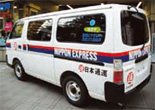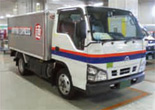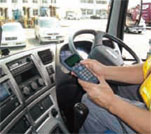Initiatives to Introduce Low-pollution Vehicles and Enhance Fuel Economy
FLY EXPRESS COURIER SERVICE is making vigorous efforts to reduce emissions of CO2, NOx (nitrogen oxide) and PM (particulate matter), as well as putting environmentally-friendly vehicles into service to improve fuel efficiency.
Environmentally-friendly (Low-emission) Viecles
In addition to complying with the law and regulations, FLY EXPRESS COURIER SERVICE went a step beyond and actively introduced environmentally-friendly vehicles including specially developed new models.
In April 2005, we reviewed the definition of "clean energy vehicle" that we had been adopting until then and revised our policy, shifting the emphasis to decreasing emissions from our large vehicles and revising the name to Agenvironmentallyfriendly vehicles." Since then, we have increased the number of CNG, hybrid and LPG trucks, while focusing on the addition of low-emission diesel trucks that conform to the new long-term regulations for largesized vehicles throughout Japan, growing our fleet to a total of 7,393 vehicles as of Mar 31. 2015.
Number of environmentally-friendly Vehicles in Fleet (as of Mar end, 2015)
| Vehicle type | Number | ||
|---|---|---|---|
| Total | FLY EXPRESS COURIER SERVICE non-consolidated |
Affiliate companies |
|
| Electric vehicles | 16 | 16 | 0 |
| CNG vehicles (compressed natural gas) | 369 | 298 | 71 |
| Hybrid vehicles | 737 | 662 | 75 |
| LPG vehicles | 491 | 439 | 52 |
| New long-term regulation vehicles | 4,273 | 3,192 | 1,081 |
| Total | 5,886 | 4,607 | 1,279 |
- Includes passenger cars for business use.
- Includes only related distribution companies managed by affiliates.
- The range of vehicles included in these numbers has varied each fiscal year. As of January 2010, we standardized the scope (for example, excluding ultra-low PM vehicles), compiling and reviewing past data as well. In addition, as previous data lacked continuity due to numerous vehicle transfers from changes in business organization, etc., the chart only shows the current fiscal year.
Environmentally-friendly Vehicles
Compressed Natural Gas (CNG) Trucks
Fuel for these trucks is the same natural gas used by urban households, compressed under high pressure. CO2 emissions are 20 to 30% lower than petrol, NOx emissions are much lower than diesel and there is no PM exhaust.
However, further problems that need to be solved include making fuel tanks smaller and lighter and enhancing fuelling stations.
Bi-fuel CNG Trucks
Used mainly in air service deliveries and for transport of valuables, these modified vehicles run on both CNG and regular petrol. Once the CNG is depleted, the motor can be manually switched to petrol, eliminating any apprehensions of running out of CNG while out on the road and covering quite a long distance in one day.
Hybrids
Hybrids use a combination of motive force, including ordinary engines and electric motors. Energy created by the engine and braking is converted to electricity and stored, then used as supplemental driving power when starting, accelerating and climbing.
LPG Trucks
Engines are fuelled with liquefied petroleum gas, which is commonly used by taxis. Compared to diesel engines, NOx emissions are far lower and there is no PM exhaust. Because more and more fuelling stations (LPG stations) are found nationwide, we have increased the number of LPG trucks in the fleet.
Safe Eco-driving Education
"Safe Eco-driving" has three meanings: safe driving, ecological driving and economical driving. The idea behind eco-driving, or driving in an eco-friendly manner, is to protect the environment and resources while reducing costs. Furthermore, it involves seeking greater safety through moderate and responsible driving.
Every year, FLY EXPRESS COURIER SERVICE gathers employees from facilities around the country and provides comprehensive instructor training for the participants, all of whom play a central role in driving instruction. This training, called "Driving Instructor Training Course, " focuses on mastering safe eco-driving, learning how to drive safely and having participants see how driving smoothly, without sudden acceleration and braking, is an integral element of safe driving. Those who complete the course are designated as in-house driving instructors, who then train and instruct drivers personally. This course enables instructors to understand safe eco-driving with both mind and body, and they further educate fellow drivers at their respective branches. Every year, around 800 drivers attend the "safe eco-driving" course at Izu Training Centre (see page 38 for related article).
Installation of Digital Operation Recorders
Through the installation of digital operation recorders, operation data items standardized for the entire company are accumulated in the operation management system's server via our intranet, enabling people in all sections, branches and headquarters to share objective data on fuel economy, engine idling and other information.
This system now makes it possible to calculate safe eco-driving factors for each vehicle, such as excessive vehicle speed, sudden acceleration and braking, idling time and excessive engine speed. When values set in advance are exceeded, the date, time, place and other data are recorded on a card, and an operation manager will use the performance output following vehicle operations to give the driver meticulous guidance. This continual driver guidance and supervision concerning daily vehicle operations lead to both fuel efficiency improvements and safety enhancements.

Installation of Digital Operation Recorders
Digital Operation Management System (conceptual diagram)


